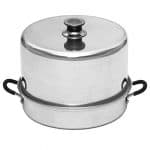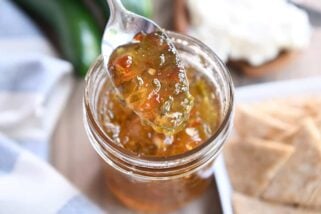The Best Homemade Salsa {Fresh or For Canning}
A step-by-step canning guide to the best homemade salsa on the planet! This is the only salsa I make because it is perfect for eating right away and even better when canned and put on the shelves to enjoy all year long.
Oh my goodness, this is the best homemade salsa ever.
I’ve been wanting to share it for a long time and finally put a step-by-step canning guide together for those that are new to canning or hesitant to try it (spoiler alert: it’s easy, and I really mean that).

With perfectly balanced flavors, somehow this salsa has become my go-to – both for canning and for eating right away.
It is fantastic and I’m always asked for the recipe when I decide to part with a jar.
I think Brian would revolt if I decided to change salsa loyalties.

You may not realize it, but salsa can be a very personal thing.
I used to kind of roll my eyes at people who got heated (no pun intended) over which homemade salsa recipe is the best (most of the aforementioned people don’t give out their secret recipes so I’ve had to end my friendship with them).
Now that I have The One, I have started to understand the passion, excitement and drama surrounding salsa.
I’d pretty much arm wrestle anyone who is willing just to prove that this is the best salsa ever.
Of course, I’d lose (wimpy arms) so we’d have to settle it over a taste test, and I am 100% more confident in that test than in the arm wrestle results.

Making and canning salsa is definitely not hard, but there are a few things to keep in mind:
1) Use a tested recipe. Canning is a great and fun (yes, I’m a nerd) way to preserve food and keep it on your shelves, but there are many food safety concerns related to canning and it’s important to use a recipe that’s been tested to ensure the pH levels are safe over time.
2) The variety of tomatoes doesn’t necessarily matter for this recipe, but the method does. This recipe calls for draining the peeled, chopped tomatoes and you’ll definitely want to follow this step otherwise your salsa will be watery.
3) Peeling tomatoes is essential for this recipe (both from a texture and bacteria standpoint). I know my grandmother will roll in her grave, but I don’t use the traditional cut an X in the tomato, plunge it into boiling water and then submerge in an ice bath method.
Broiling Tomatoes to Remove Peel
The easiest way to remove the peel/skin from tomatoes is to cut the tomatoes in half, place them cut-side down on a baking sheet, and pop them under the hot oven broiler for 3-4 minutes (watch closely!). The skins will wrinkle right up when the pan is removed, and after they are cooled, the skins will peel off really easily.
It’s brilliantly simple and has made me not dread the process of peeling tomatoes; it’s the only way I do it.

4) Canning the salsa can be done with a water bath or steam bath canner. This recipe has not been tested (and is not recommended) for pressure canning.
There are lots of other details and notes down below in the homemade salsa recipe and the step-by-step picture guide below, so make sure to read thoroughly and feel free to ask any questions in the comments.

Mostly, I want you to know that canning salsa is easy (and therapeutic; seriously, I love canning) and even more than that, this may be the only salsa recipe you’ll ever need.
As written, it’s not spicy – just perfectly balanced with all the delicious flavors of salsa. If you’ve been on the hunt for the perfect salsa recipe, this is it, baby.
So if you have homegrown tomatoes or know where to find some (please ask before you pick), this homemade salsa should be top on your list of recipes to make. I hope you love it!
A List of Canning Tools I Use For this Recipe:
*several products below are affiliate links to Amazon where I’ve bought the product from
- this over-the-sink colander is awesome for draining the tomatoes
- my trusty Breville food processor (love of my life after I had two Cuisinart food processors die sudden deaths on me) does all the chopping
- steam canner
- this simple canning toolset has just about everything I need for filling and handling the jars


The Best Homemade Salsa
Ingredients
- 10 cups peeled, chopped and drained tomatoes (see note)
- 3 cups chopped onion
- 1 ¾ cups chopped green bell pepper
- 5 medium jalapeños, finely chopped, membranes and seeds removed (leave in for extra spice) – about 1 to 1 1/4 cups
- 7 cloves garlic, finely minced
- 2 ½ teaspoons ground cumin
- 2 ½ teaspoons coarsely ground black pepper
- 2 ½ tablespoons canning or pickling salt (see note)
- ⅓ cup chopped fresh cilantro
- ⅓ cup sugar, optional, depending on sweetness of tomatoes
- 1 ¼ cups apple cider vinegar (see note)
- 16 ounces tomato sauce, NOT optional – necessary for safe canning/proper pH
- 12 ounces tomato paste, optional if you want a thicker salsa
Instructions
- Combine all the ingredients in a large pot and bring to a boil. Reduce the heat and simmer for 10 minutes, stirring often.
- Fill sterilized pint-size canning jars within 1/2-inch of the top. Wipe the rim of the jar clean and seal with a lid and ring.
- Process in a water or steam bath canner for 15 minutes (add 5 minutes if you live at 1,001 to 3,000 feet; add 10 minutes for 3,001 to 6,000 feet; add 15 minutes for 6,001 feet to 8,000 feet).
- Remove the jars carefully from the water or steam bath and let cool to room temperature. Check to make sure the jars have sealed correctly (lightly press the top of the lid; it should be firm – if the center bubbles up and down when you press on it, it hasn’t sealed correctly and will need to be refrigerated or re-processed).
Notes
Recipe Source: adapted slightly (increased all the quantities appropriate for canning safety) from this recipe I found on the awesome GardenWeb site










This is an amazing recipe. Thank you! Question: we are getting late season tomatoes. So needing to bring them inside to wait while they ripen. Can I prep the tomatoes that are ripe and then preserve that until I have more? Meaning broil, peel, drain? And then put in the fridge for a few days until the rest are ready?
Yes, that works great!
Do you have this recipe somewhere that converts to a smaller batch? I would like to try it before canning a large batch and not being a fan. Also sometimes I just want to make some for one evening.
I don’t have the recipe saved elsewhere for a smaller batch – you’d need to just cut down the ingredients accordingly.
Delicious Salsa, and easy to make!
I’m not a big salsa fan but I Loved it! My family loved it too! Thank you for all the little details as well! Made it very easy to prepare correctly.
I’m not a salsa fan, but this made me a believer! Very rewarding to make. Loved it, and loved that you took the time to explain why things needed to be done a certain way. Thank you! We all love it.
This is the BEST salsa I’ve had! It checks off the salty, tangy, spicy, cravings of good salsa!
I made it and combined Apple Cider Vinegar, White Vinegar, and some lime juice to equal the total amount of vinegar in the recipe. I used a variety of hot peppers, seeds removed, because I grow about 20 different varieties of hot peppers. I did take the time to blanch the tomatoes and removed the seeds and peels. I charred some of the onions and peppers to give more flavor. I added some chopped green onion when I added the cilantro.
Take my word for it. It is killer good!!